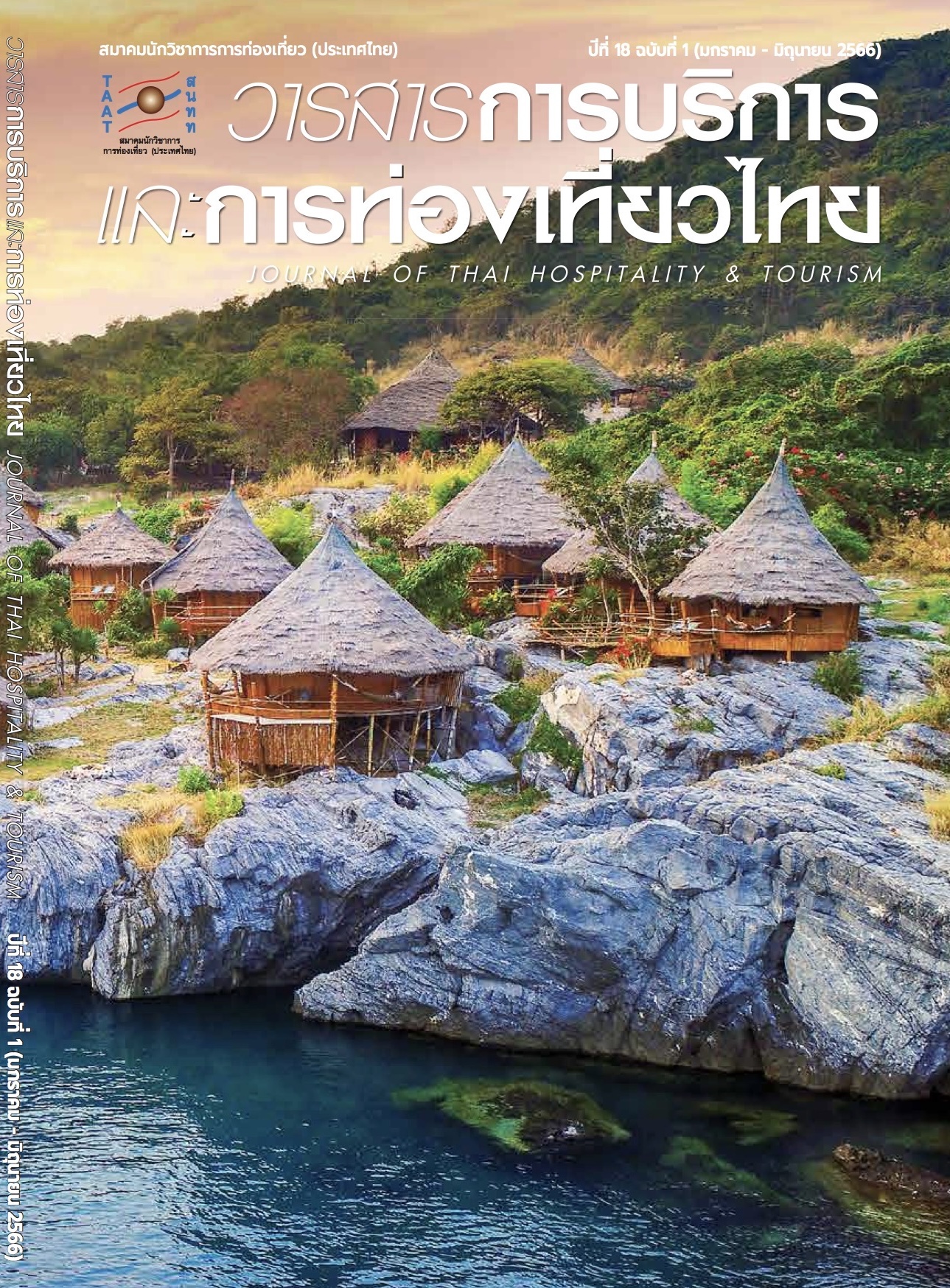Tourist Behavior, Travel Anxiety, Electronic Word of Mouth Perception, and the Travel Intentions of Muslim Tourists after the Covid-19 Pandemic
Main Article Content
Abstract
This qualitative study was designed to investigate the effects of tourist behavior, travel anxiety, and electronic word-of-mouth perception on the travel intentions of Muslim tourists living in the 14 southern provinces of Thailand after the COVID-19 pandemic and included four hundred participants. This research used an online questionnaire to collect data. Descriptive and inferential statistics were used to examine the factors that affected travel intention, including percentages, standard deviations, and stepwise multiple regression analysis. The findings revealed that Muslim tourists placed a high value on travel safety, with a high level of perceived electronic word-of-mouth communication and travel intention, but the survey revealed that they had a low level of travel anxiety.
The results from the stepwise multiple regression analysis showed a statistically significant effect of electronic word-of-mouth perception, travel anxiety, travel expenses, length of travel per time period, and traveling after the COVID-19 pandemic on travel intentions. Thus, the government and private sectors related to tourism should focus on safety and cleanliness. Furthermore, operators in the tourism industry should strive to improve the perception of their services by providing adequate facilities for Muslim tourists.
Article Details

This work is licensed under a Creative Commons Attribution-NonCommercial-NoDerivatives 4.0 International License.
References
Abdullah, M., Ali, N., Hussain, S. A., Aslam, A. B. & Javid, M. A. (2021). Measuring Changes in Travel Behavior Pattern due to COVID-19 in a Developing Country: A Case Study of Pakistan. Transport Policy, 108(c), 21–33.
Ahn, J. C., Cho, S. P. & Jeong, S. K. (2013). Virtual Reality to Help Relieve Travel Anxiety. KSII Transactions on Internet and Information (TIIS), 7(6), 1433–1448.
Albarq, A. N. (2013). Measuring the Impacts of Online Word-of-Mouth on Tourists’ Attitude and Intentions to Visit Jordan: An Empirical Study. International Business Research, 7(1), 14–22.
Alvandi, E., Dellazenda. & Sihombing, S. O. (2020). Testing Travel Intention Model: An Empirical Study of Borobudur Temple. Jurnal Manajemen, 24(2), 327–341.
Bangkokbiznews. (2020). Booking.com Reveals the Trend of Thai Tourists’ Behavior after COVID-19. https://www.bangkokbiznews.com/news/detail/909641
Carlson, K. D. & Herdman, A. O. (2012). Understanding the Impact of Convergent Validity on Research Results. Organizational Research Methods, 15(1), 17–32.
Chiangphan, N. & Vongsaroj, R. (2017). Factor Affecting to the Travel Behavior of the Foreign Female Tourist in Bangkok. Journal of International and Thai Tourism, 13(2), 105–123.
Cochran, W. G. (1953). Sampling Techniques. John Wiley and Sons.
Elsayeh, Y. (2020). Post COVID-19: Potential Effects on Egyptians’ Travel Behavior. Global Journal of Management and Business Research: (F) Real Estate, Event, Tourism Management & Transporting, 20(3), 24–31.
Fakharyen, M., Jalilvand, M. R., Elyasi, M. & Mohammadi, M. (2012). The Influence of Online Word-of-Mouth Communications on Tourists’ Attitudes toward Islamic Destinations and Travel Intention: Evidence from Iran. African Journal of Business Management, 6(38), 10381–10388.
Hashim, N. A. A. N., Noor, M. A. M., Awang, Z., Aziz, R. C. & Yusoff, A. M. (2018). The Influence of Tourist Perceived Risk towards Travel Intention: A Conceptual Paper. International Journal of Academic Research in Business and Social Sciences, 8(16), 92–102.
Hsu, P. Y., Ku, E. C. S., Lai, T. C. & Hsu, S. (2022). Developing a Muslim Tourism Market: the Perspective of Travel Agencies. Journal of Hospitality and Tourism Insights, 5(1), 166–185.
Jalilvand, M. R., Esfahani, S. S. & Samiei, N. (2011). Electronic Word-of-Mouth: Challenges and Opportunities. Procedia Computer Science, 3, 42–46.
Jittijarunglap, K. (2019). The Impact of Electronic Word-of-Mouth on Online Shopping Behavior. Journal of Information Systems in Business, 5(2), 43–65.
Krungthai Compass. (2020). Penetrating Tourist Behavior in the New Normal: When COVID Comes, Life Changes. Krungthai.
Luo, J. M. & Lam, C. F. (2020). Travel Anxiety, Risk Attitude and Travel Intentions towards “Travel Bubble” Destinations in Hong Kong: Effect of the Fear of COVID-19. International Journal of Environmental Research Public Health, 17(21), 7859.
Makhdoomi, U. M. & Baba, M. M. (2019). Destination Image and Travel Intention of Travellers to Jammu & Kashmir: the Mediating Effect of Risk Perception. Journal of Hospitality Application & Research, 14(1), 35–56.
Ministry of Tourism and Sports (MOTS). (2021). Tourism Statistics 2021. https://mots.go.th/more_news_new.php?cid=628
Reisinger, Y. & Mavondo, F. (2005). Travel Anxiety and Intentions to Travel Internationally: Implications of Travel Risk Perception. Journal of Travel Research, 43(3), 212– 225.
Saenkam, B. (2021). The Behavior of Thai Tourists after COVID 19 Situations. Journal of Liberal Arts and Service Industry, 4(1), 160–167.
Saenyen, T., Sirijaruanan, T., Haso, A. & Khattangchon, S. (2018). Marketing Trend in Friendly Muslim Tourism. Journal of Pacific Institute of Management Science, 4(1), 286–297.
Srithammasak, N. & Akkapin, S. (2018). The Study of Foreign Tourists Behavior towards Taling–Chan Floating Market. Journal of Thai Hospitality and Tourism, 13(1), 27–35.
Taherdoost, H. (2016). Validity and Reliability of the Research Instrument: How to Test the Validation of a Questionnaire/Survey in a Research. International Journal of Academic Research in Management, 5(3), 28–36.
Viangin, S. (2016). The Study of Factors Positively Affecting Intention to Travel of the Visitors of “Thai-Teaw-Thai” Event. Bangkok University.
Vinijvorakijkul, N., Sae–Wang, R. & Kanchanakhuha, W. (2018). Human Capital Development in Tourism Industry in the ASEAN Framework. Kasem Bundit Journal, 19(1), 45–60.
Zarrad, H. & Debabi, M. (2015). Analyzing the Effect of Electronic Word-of-Mouth on Tourists’ Attitude toward Destination and Travel Intention. International Research Journal of Social Sciences, 4(4), 53–60.


